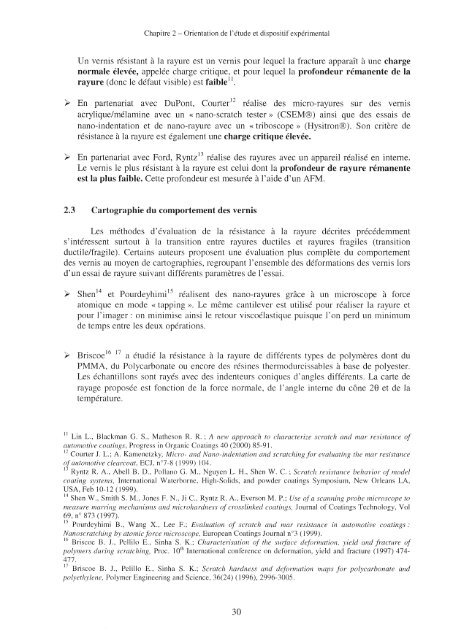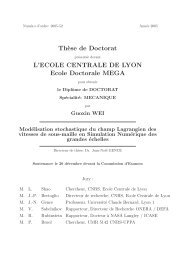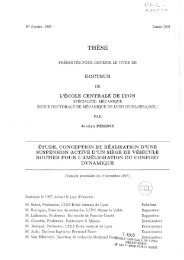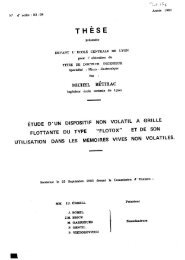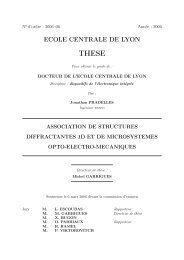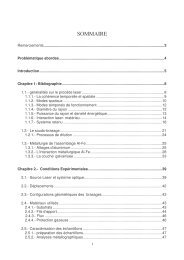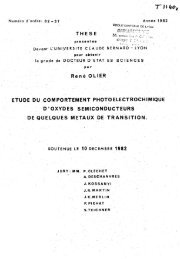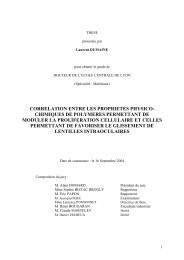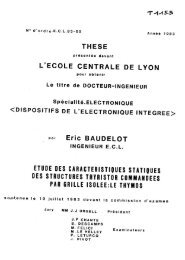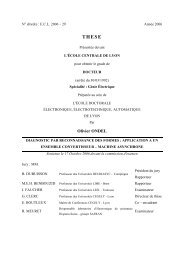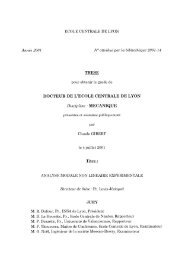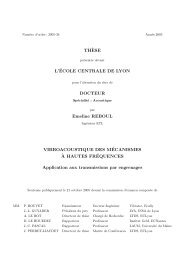Sur les mécanismes de rayures des vernis de finition automobiles
Sur les mécanismes de rayures des vernis de finition automobiles
Sur les mécanismes de rayures des vernis de finition automobiles
You also want an ePaper? Increase the reach of your titles
YUMPU automatically turns print PDFs into web optimized ePapers that Google loves.
Chapitre 2<br />
Orientation <strong>de</strong> 1'etu<strong>de</strong> et dispositif cxprirnenta1<br />
Un <strong>vernis</strong> résistant à la rayure est un <strong>vernis</strong> pour lequel la fracture apparaît à une charge<br />
normale élevée, appelée charge critique, et pour lequel la profon<strong>de</strong>ur rémanente <strong>de</strong> la<br />
rayure (donc le défaut visible) est faible''.<br />
En partenariat avec DuPont, Courter'2 réalise <strong>de</strong>s micro-<strong>rayures</strong> sur <strong>de</strong>s <strong>vernis</strong><br />
acrylique/mélamine avec un «nano-scratch tester» (CSEM®) ainsi que <strong>de</strong>s essais <strong>de</strong><br />
nano-in<strong>de</strong>ntation et <strong>de</strong> nano-rayure avec un «triboscope» (Hysitron®). Son critère <strong>de</strong><br />
résistance à la rayure est également une charge critique élevée.<br />
> En partenariat avec Ford, Ryntz'3 réalise <strong>de</strong>s <strong>rayures</strong> avec un appareil réalisé en interne.<br />
Le <strong>vernis</strong> le plus résistant à la rayure est celui dont la profon<strong>de</strong>ur <strong>de</strong> rayure rémanente<br />
est la plus faible. Cette profon<strong>de</strong>ur est mesurée à l'ai<strong>de</strong> d'un AFM.<br />
2.3 Cartographie du comportement <strong>de</strong>s <strong>vernis</strong><br />
Les métho<strong>de</strong>s d'évaluation <strong>de</strong> la résistance à la rayure décrites précé<strong>de</strong>mment<br />
s'intéressent surtout à la transition entre <strong>rayures</strong> ducti<strong>les</strong> et <strong>rayures</strong> fragi<strong>les</strong> (transition<br />
ductile/fragile). Certains auteurs proposent une évaluation plus complète du comportement<br />
<strong>de</strong>s <strong>vernis</strong> au moyen <strong>de</strong> cartographies, regroupant l'ensemble <strong>de</strong>s déformations <strong>de</strong>s <strong>vernis</strong> lors<br />
d'un essai <strong>de</strong> rayure suivant différents paramètres <strong>de</strong> l'essai.<br />
Shen' et Pour<strong>de</strong>yhimi'5 réalisent <strong>de</strong>s nano-<strong>rayures</strong> grâce à un microscope à force<br />
atomique en mo<strong>de</strong> « tapping ». Le même cantilever est utilisé pour réaliser la rayure et<br />
pour l'imager : on minimise ainsi le retour viscoélastique puisque l'on perd un minimum<br />
<strong>de</strong> temps entre <strong>les</strong> <strong>de</strong>ux opérations.<br />
Briscoe'6 '<br />
a étudié la résistance à la rayure <strong>de</strong> différents types <strong>de</strong> polymères dont du<br />
PMMA, du Polycarbonate ou encore <strong>de</strong>s résines thermodurcissab<strong>les</strong> à base <strong>de</strong> polyester.<br />
Les échantillons sont rayés avec <strong>de</strong>s in<strong>de</strong>nteurs coniques d'ang<strong>les</strong> différents. La carte <strong>de</strong><br />
rayage proposée est fonction <strong>de</strong> la force normale, <strong>de</strong> l'angle interne du cône 20 et <strong>de</strong> la<br />
température.<br />
° Lin L.. Blackman G. S,, Maiheson R. R. ; A new approach to charcicierize scratch cmcl ,iiar resistance of<br />
automotive coatings, Progress in Organic Coatings 40 (2000) 85-91<br />
2<br />
Courter J. L.; A. Kanìenezky, Micro- and Nano-in<strong>de</strong>nration and scratching f)r evaluating the mar resistance<br />
of automotive clearcoat, ECJ, n7-8 (1999) 104,<br />
Ryniz R. A.. Ahell B. D., Pollano G. M.. Nguyen L. H.. Shen W. C. ; Scratch resistance behavior of mo<strong>de</strong>l<br />
coating systems, International Waterhorne, High-Solids, and pow<strong>de</strong>r coatings Symposium, New Orleans LA,<br />
USA, Feb 10-12 (1999).<br />
14<br />
Shcn W.. Smith S. M., Jones F. N., Ji C.. Ryniz R. A., Everson M. P.: Use of a scanning probe mIli(r(.'vcnpe to<br />
measure marring mechanisms and nmìcrohardness oJcrossiinked coatings, Journal of Coatings Technology, Vol<br />
69, n° 873 (1997).<br />
><br />
Pour<strong>de</strong>yhimi B., Wang X., Lee F.; Evaluation of scratch an.d mar resistance in automotive coatings<br />
Nanoscrarching by atomic force microscope, European Coatings Journal n3 (1999).<br />
Briscoe B. J., Pellilo E., Sinha S. K.: Characrerïsarion of the sudce <strong>de</strong>formation, yield and fracture of<br />
polymers during scraiclung, Proc. 10 International conference on <strong>de</strong>formation, yield and fracture (1997) 474-<br />
477,<br />
17<br />
Briscoe B. J., PeIïllo E., Sinha S. K.; Scratch hardness and <strong>de</strong>formation maps for polycarbonate and<br />
polyethylene. Polynier Engineering and Science, 36(24) (1996), 2996-3005.<br />
30


